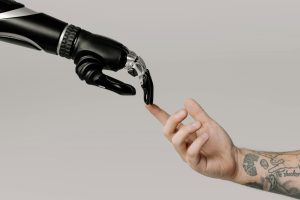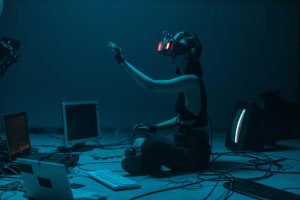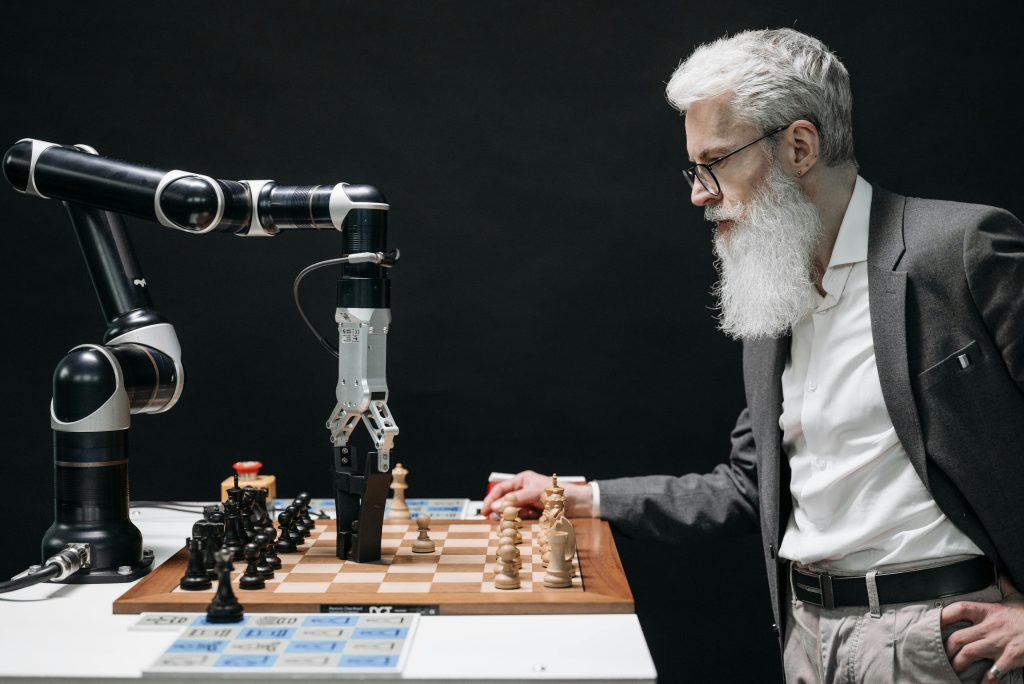With the emergence of artificial intelligence (AI) dependency and the persistent integration of AI technology into education and health care fields, we discuss how AI can support medical professionals with supporting roles without taking over the vital backbones of medicine: humans.
Utopia or Dystopia?
“You’re in good hands,” says your anesthesiologist, warmly reassuring you as they prep you for surgery. Post-operation, you wake up to a voice that sounds almost robotic. “Your surgery was a success! You’ll be staying overnight to get lots of rest, and you will need to”…
Hold on. Are you hallucinating? You blink your eyes profusely and find your focus falls onto the robot standing at your hospital bedside telling you about your procedure and recovery expectations. Did artificial intelligence (AI) seriously just perform surgery on you?
In today’s rapidly advancing medical technology field, AI in surgeries and diagnostic health care is no longer the introduction to a science fiction novel placed in a utopia (or dystopia) novel — it actually may be your reality, or we may be right around the corner from it. This article serves as an update on what’s happening with AI’s current capacities in medicine and its leverage in supporting health roles.
Polarizing opinions and debates surrounding AI acceptance and its role in the classroom and daily life are a popular choice to some but a terrifying or upsetting concern to others — let alone in medicine. Some are excited by AI’s accuracy and potential to terminate illnesses, while others may hold fear or distrust in AI’s inability to feel, or some may argue, its potential capacity to take away jobs. This article aims to collide both worlds and speak for ways AI can play life-changing supporting roles in healthcare without taking away our reliance on doctors’, nurses’, or surgeons’ roles.

Code at our fingertips. (Image Source: Pexels)
Smart Apps for Life Quality Support and Investment
Beyond the hospital setting, AI has the capacity to improve our quality of life through early cancer detection and memory support right in our pockets, using apps such as SkinVision and HippoCamera. SkinVision is a mobile dermatologist app that allows users to take a photo of their skin—any pigmentation and/or moles they have or acquire—to have them analyzed for skin cancer and skin health. You should always seek a medical professional for all medical advice, but cancer detection AI can help identify potential warning signs early and prompt you to visit a doctor to receive a diagnosis sooner.
HippoCamera is a digital memory augmentation app that allows individuals to record 20-second videos of events they’d like to remember along with 8-second audio descriptions. It uses memory cues to facilitate recollection and mimic the hippocampus, sharpening the user’s hippocampal function and rehabilitating their memory. Patented by psychology professor Morgan Barense, this groundbreaking technology is especially useful for those in the aging demographic with neurodegenerative diseases or brain lesions that induce memory loss as it aids their recollection abilities improves their quality of life, sense of connectedness and relationships.
AI Augments Diagnostic Screening Accuracy
In addition to improving our quality of life, AI also acts as a valuable tool to improve diagnostic screening accuracy. James Somers wrote for The New Yorker about Cyto-AiSCAN, a groundbreaking cancer-cell detection technology that originally was created to be a pastry identifier. BakeryScan’s media popularity led to the interest of a doctor from the Louise Pasteur Center for Medical Research. The AI-Scan algorithms adapted from Brain Co. founded BakeryScan. In Kobe and Kyoto Japan, doctors successfully tested Cyto-AiSCAN by analyzing and measuring whether or not urinary cells were diseased, leading to its adoption by two prominent hospitals and improving their diagnosis to a 99% accuracy rate. AI has proven its ability to augment diagnostic pathology and non-invasive cancer screening capabilities.
Clinical Technologies to Improve Mobility and Healing
Clinical technologies are being created and clinically tested that can help those with mobility impairments (re)gain autonomy and heal skin lesions to help improve their quality of life. First, Tagoe et al. (2024) demonstrated that wearable robotic assistance, or ankle exoskeletons in particular, can aid walking speed, energy efficiency, mobility and even walking ability in individuals with neurological conditions, such as cerebral palsy. Next, Hao et al. (2020) showed that gait changes can be used to diagnose and detect early signs of chronic illness, as well as monitor recovery. 3D-printed smart insoles that have fiber Bragg grating sensors embedded are a low-cost way to monitor foot pressure and gait patterns accurately. Lastly, Liu et al. (2023) found that electronic skin (E-skin) created from acellular dermal matrix serves as a biodegradable and conductive healing material. When paired with an electrical stimulus, e-skin encourages advanced tissue repair (wound healing) and cell growth to speed up and occur, prompting skin health.

Bridging the gap: human intuition meets machine precision. (Image Source: Pexels)
UHN’s AI Integration
The Unity Health Network (UHN) is the world’s leading publicly funded and Canada’s top research hospital, continuing to lead many AI-integrating initiatives into transplant, imaging, and tumor prediction technology. The UHN’s Ajmera Transplant Center curated a transplant AI initiative, North America’s largest transplant program, that has allowed the implementation of AI to effectively allocate organs and donor/recipient matching.
The UHN’s AI Hub leaders, Dr. Shaf Keshavjee, Chief of Innovation, and Dr. Bo Wang, Chief AI Scientist, aim to make healthcare efficient and accessible, as well as to integrate AI to improve the outcomes of patients and clinical decision-making. Marji Johne (2017) wrote for The Globe and Mail that with a $100M donation, the Peter Munk Cardiac Centre gained a partnership with the Vector Institute to pioneer AI into cardiac healthcare. AI was used to create potentially preventive therapies, increase efficiency and identify predictive modeling. Regulating approvals and training clinicians to adjust to AI may be slow processes, but experts believe machine learning is medicine’s future. The AI team aims to develop technologies to help analyze medical imaging and clinical notes, as well as to predict and prevent heart conditions, supporting precision and efficiency without replacing clinicians.
At UHN’s Princess Margaret Cancer Centre, researchers created an AI-powered radiomics method that allows for metastatic tumor treatment response predictions through CT scan analysis for leiomyosarcoma patients and machine learning for precise tumor resistance modeling. Incorporating AI allows for precise lesion-targeted therapies to foster metastatic cancer patients’ improved outcomes and expectancies.

Where identity meets algorithm. (Image Source: Pexels)
Can a Robot Perform Surgery?
According to Chaofan for the Global Times, February 28, 2025 marks a pioneering event in medical history and AI integration. Professor Tao Lei’s team successfully completed the first non-invasive glottic tumor removal surgery — it was performed entirely remotely using China’s AI-driven transoral surgical robot system. China is proving to be a leader in surgical robotics, proving AI’s precision and potential in medical innovation. Remote surgeries have the capacity to be recorded and used in surgical trainings, allowing surgeons to operate life-saving procedures from anywhere in the world.
However, Adegbesan et al. (2024) caution that the implementation of surgical robots may create concerns about deskilling surgeons who overly rely on AI by harming their autonomy in decision-making, thus increasing the number of errors made in surgery. If a cyber-attack or malfunction occurs, the surgeon, previously accustomed to excessive reliance on AI feedback, may lack the conventional skills necessary to confidently and accurately perform successful surgery.
AI Limitations
Although the integration of AI into our heathcare and education systems has great potential to improve the quality of our lives, it isn’t without limitations. Researchers Wubineh et al. (2024) conducted a systematic review that highlights the key strengths and challenges of AI integration in health care. AI provides opportunities to improve diagnosis, patient monitoring, drug development, efficiency, the management of health data and assist in surgery but may also present challenges such as lack of trust from some healthcare professionals, as well as data bias, liability and privacy concerns. Austin Littrell (2025) wrote for Medical Economics about AI’s inability to feel empathy and lack of adaptability, emphasizing that technology should not diminish medicine’s humanity but aim to enhance it. Once the challenges of AI’s novelty in medicine are proactively addressed and with the passage of time, it may be arguably interesting (or nerve-wracking to some) to observe how implementing AI will shape healthcare and decision-making.

In a world of code and clutter, the human touch still leads. (Image Source: Pexels)
Conclusion
The integration of AI is revolutionizing our access to healthcare through smartphone apps, encouraging early detection and diagnostic pathology, allowing for more effective transplant matching and allocation, and allowing surgeons to potentially operate on patients remotely. The question behind AI implementation into healthcare no longer asks if AI belongs, but if we are integrating AI at sustainable and responsible rates. A general call for future research is to investigate to what extent AI should be kept in supporting or leading roles and how we can protect the autonomy of healthcare professionals and prevent over-reliance on AI without underutilizing its benefits.


